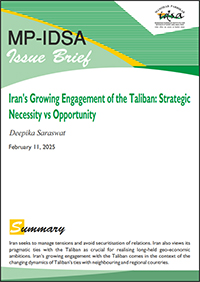Iran’s Growing Engagement of the Taliban: Strategic Necessity vs Opportunity
- February 11, 2025 |
- Issue Brief
Summary
Iran seeks to manage tensions and avoid securitisation of relations. Iran also views its pragmatic ties with the Taliban as crucial for realising long-held geo-economic ambitions. Iran’s growing engagement with the Taliban comes in the context of the changing dynamics of Taliban’s ties with neighbouring and regional countries.
Iran’s Foreign Minister Sayed Abbas Araghchi visited Kabul on 26 January 2025.[1] It was the first visit by an Iranian foreign minister to the Afghan capital since 2017. Araghchi held meetings with several high-level officials of Taliban’s interim government, including Prime Minister Mohammad Hassan Akhund, Foreign Minister Amir Khan Muttaqi, Minister of National Defense Mohammad Yaqoob and Minister of Industry and Commerce, Nooruddin Azizi.
The timing of the visit was crucial for several reasons. In December 2024, Alireza Bigdeli replaced Hassan Kazemi Qomi as the head of Iran’s mission in Kabul, raising expectations among the Taliban that the new government in Iran will accept their ambassador and recognise the ‘Islamic Emirate in Afghanistan’. Bigdeli, in his first meeting with Muttaqi, had stated that he will facilitate a high-level delegation exchange between the two countries in the near future. It is, therefore, noteworthy that the first ministerial visit from Iran to Taliban-ruled Afghanistan has come under the reformist Masoud Pezeshkian administration.
When compared with the conservatives, reformist leaders have taken a harsher view of the Taliban’s extremist ideological approach to governance. However, the Pezeshkian administration has several pragmatic reasons for continuing and even expanding engagement with Taliban. The return of Donald Trump as the president of the United States has made Iran nervous about a renewed ‘maximum pressure’. Taliban faces new security and economic challenges as Trump has announced ‘pause’ on foreign aid program and is demanding recovery of what he claims to be US$ 85 billion worth of the US military equipment left behind in Afghanistan when the US forces left in 2021. Without the aid, Taliban will struggle to pay for fuel, electricity, food and other necessary imports from neighbouring countries including Iran.
Taliban has also come under renewed international pressure after the International Criminal Court issued arrest warrants for senior Taliban leaders Haibatullah Akhundzada and Abdul Hakim Haqqani for the crimes against humanity of persecution on gender grounds in Afghanistan. These challenges have come in the wake of an intensifying factional struggle for power in the Taliban over increasing restrictions on women.
Tehran does not want renewed instability in Afghanistan which will negatively impact security in Iran’s border region and will send more Afghan refugees and migrants into Iran. Further, the rapid slide in Taliban’s ties with Islamabad after Pakistani military’s latest air raids in Afghanistan on 25 December 2024, has also led Tehran to make renewed outreach to other countries including India and Iran. Moreover, Tehran and Taliban are pursuing dialogue to manage tensions over several bilateral issues. Tehran seeks Taliban’s cooperation to alleviate border security concerns including drug trafficking from Afghanistan into Iran and enabling water sharing from Helmand River and return of undocumented migrants to Afghanistan. At the same time, Iran is also keen to enhance economic ties with Afghanistan, currently its fourth largest export destination.
Water-Sharing Disputes
The protracted dispute over sharing waters of the transboundary Helmand River and Harirud has become a key issue in Iran–Taliban relations. Notably, Helmand, Harirud and Amu Darya are among the four major river systems to emerge from the Central Afghan Highlands and flowing into neighbouring country. For decades, Afghan rulers including the Taliban have focused on constructing embankment dams to divert water into irrigation canals, while also developing leverage over their neighbours who depend on cross-border flows. Since 2016, when Afghanistan opened Salma Dam, also called Afghan–India Friendship Dam (as it was built with Indian assistance), on the upper reaches of the Harirud River in Herat province, both Iran and Turkmenistan have been concerned about restriction of the natural flow of water in the lower reaches of the river. Mashhad, Iran’s second largest city, depends on water pumped from Doosti dam jointly built by Iran and Turkmenistan. In December 2024, the Taliban announced that the construction of the Pashdan Dam in Herat is 80 per cent complete and will soon become operational. Iran protested against the “unilateral dam construction measures of the Afghan side and called for joint cooperation to evaluate and reduce negative cross-border effects”.[2]
Similar issues have persisted on the Helmand River, which originates from the Hindukush mountains north of Kabul and drains into Hamoun Lake and wetlands in Sistan-Baluchistan province of Iran. The construction of numerous dams and canals in Helmand, Nimruz and Kandahar have depleted water flow resulting in desiccation of transboundary wetlands, causing drought and severe dust-storms in Sistan and Baluchestan. Tehran has been calling on the Taliban to honour the obligations arising from the unbinding Helmand Treaty of 1973. While Taliban has expressed commitment to implement the water sharing treaty, it claims that the dams built on Helmand do not have sufficient water because of draught and climate-change related reasons.
In May 2023, Iranian President Ebrahim Raisi, during a visit to Sistan and Baluchestan province used forceful language, warning Taliban to open the gates of Kajaki dam. As tensions escalated over water sharing, the Taliban and Iranian border guards engaged in violent clashes along Zabol-Nimroz border. However, both sides preferred de-escalation and Taliban agreed to a visit of Iranian hydrological experts to Deh Ravod and Kajakai Dam, which took place in early August 2023.[3] In January, President Pezeshkian paid a two-day visit to Sistan and Baluchestan. In an interview with the provincial channel, he had said that his administration plans to hold talks with Afghanistan to uphold water rights of the province from the Helmand River. Though Araghchi raised water sharing issues in all his meetings, Taliban repeated its previous position that “Afghanistan remains committed to its obligations regarding Iran’s water rights” and insisting that the main obstacles were of climatic origin.[4]
Border Security Challenges
The illegal crossing of migrants and refugees from Afghanistan into Iran is another key bilateral issue between Iran and the Taliban. In November 2024, Iran’s police chief Brigadier General Ahmadreza Radan announced that the law enforcement forces had deported some 8 lakh illegal Afghan immigrants over the last six months and that they will follow through its promise to deport 2 million Afghan illegals by the end of the current Iranian year (20 March 2025).[5]
For over four decades, Iran has hosted one of the largest refugee populations, mainly from neighbouring Afghanistan. According to government estimates, Iran hosts at least 4.5 million Afghan refugees, 71 per cent of whom are women and children. The figure also includes some 2.6 million undocumented Afghans. Iranian officials have complained about insufficient international aid and constraints under economic sanctions to provide necessary services to refugees and illegals. After the Taliban’s return to power, Iran has grappled with a new wave of Afghan refugees.[6]
Citing lack of resources, Iran deported over one million refugees to Afghanistan in 2021. In 2023, amid escalated tensions over water sharing and border clashes, Iranian authorities announced comprehensive measures to deport and prevent the entry of undocumented Afghan nationals.[7] On several occasions, the Taliban has accused Iranian border guards of using lethal force on Afghan nationals trying to make illegal entry or those engaged in cross-border smuggling. In July 2024, Brigadier General Ahmad Akbari, the commander of Army’s Ground Forces engineering group, during a visit to Taybad city, close to Dogharoun border crossing, announced that the “technical operations for the closure are being carried out along the 300-kilometer border shared between Khorasan Razavi province and Afghanistan”. On the technical specifications of the concrete wall, along with barbed wire and fencing, he noted that it is 4 meters high and 1 meter in thickness. The US$ 3 billion projected is expected to be completed over the next three years.[8]
Iran’s renewed moves to secure borders with Afghanistan have come after violent border clashes and Iranian accusations that the Taliban lacks understanding of border protocols and its border forces on several occasions have violated the border.[9] However, Tehran has assessed that any escalation on the border will be exploited by external forces hostile to Iran. Iranian authorities have, therefore, preferred dialogue and cooperation with Taliban in addressing the issues relating to border security. Addressing the Iranian media after his visit to Afghanistan, Araghchi stated that during his talks with officials in Kabul, the two sides emphasised the critical importance of cooperation between border authorities of the two countries.[10]
Economic Opportunities
In Kabul, Araghchi together with Nooruddin Azizi, Taliban’s Acting Minister of Industry and Commerce, attended a meeting of Iranian-Afghan private sector businesses. Both sides agreed to further discuss removal of trade barriers and tariffs. They also agreed to addressing challenges in border markets, increasing Afghan exports to Iran, reducing transportation and transit costs and maximising the use of the Chabahar port.[11] Iran exported non-oil commodities valued at US$ 1.6 billion to Afghanistan during the first eight months of the current Iranian calendar year, which starts from 20 March. To counter the US sanctions, Iran prioritises trade and economic ties with neighbours including Afghanistan. Further, Iran is keen to maintain its position of key trading partner of Afghanistan and also make progress on stalled connectivity projects involving Afghanistan.
After India and Iran signed a 10-year contract for India to develop and operate the Shahid Beheshti terminal in May 2024, the Taliban has also shown greater interest in the port. Notably, the port was granted waiver from the sanctions-based ‘maximum pressure’ launched on Iran by Trump during his first term. Only days after Trump secured a second term, an Indian delegation headed by JP Singh, Joint Secretary of the Pakistan–Afghanistan–Iran division in the Ministry of External Affairs, met Taliban’s Acting Defence Minister Mullah Mohammad Yaqoob, offering the use of Chabahar Port to business groups in Afghanistan and extending more humanitarian assistance to Kabul.[12] As the Taliban’s ties with Pakistan continue to deteriorate, Chabahar gains in importance as an alternative to Karachi port. Over the last year, the Taliban has intensified talks with Iran opening a commercial office in Chabahar and participation of the private sector of Afghanistan in developing facilities at the port.
Afghanistan which borders Tajikistan, Uzbekistan, Turkmenistan and also Iran and Pakistan, is envisaged as the land bridge connecting landlocked Central Asia with the Indian Ocean. At the same time, Afghanistan’s role in east–west connectivity has received attention. The Taliban is keen to utilise Afghanistan’s transit potential by simultaneously engaging Uzbekistan, Turkmenistan and Pakistan and Iran on the other hand in various trans-Afghan connectivity projects. Both Iran and India would like the Taliban to revive Afghanistan’s participation in the 2016 Trilateral Chabahar Agreement on the establishment of an International Transit and Transport Corridor through Afghanistan.
In 2020, Iran began constructing a 631 km long Chabahar–Zahedan Railway as the crucial link in north–south route connecting Central Asia, Afghanistan and India via Iran. Under a tripartite agreement with India and Afghanistan and Iran, Iran started working on the 225 km Khaf–Herat railway, aimed at connecting Afghanistan to Iran’s seaports but also a part of the ‘five nations’ railway project linking Iran with China through Afghanistan, Tajikistan and Kyrgyzstan. The 140 km section from Khaf to Rozanak in Afghanistan was inaugurated in December 2020, while Italy was to fund the last section to Herat.[13]
In December 2022, Iran and the Taliban reached an agreement to repair the damages incurred to Rozanak Station and subsequently the railway was relaunched in 2023. Uzbekistan’s rail connectivity with Afghanistan comprises a single track line from Hairatan near Uzbek–Afghan border to Mazar-e-Sharif, opened in 2011. Iran would like to extend it from Mazar-e-Sharif to Herat, but Uzbekistan is keen to enhance its own role as regional transit hub trough a trans-Afghan railway along the Termez-Mazar-i-Sharif-Kabul-Peshawar route. Notably, Uzbek Prime Minister Abdullah Aripov’s two-day visit to Kabul in August 2024 was the highest-level visit of any foreign dignitary to Taliban-ruled Afghanistan.[14] The visit was focused on cooperation in transit and trade, with the two countries signing a preferential trade agreement eliminating import duties on 14 types of goods. The competitive dynamics of transport corridors via Afghanistan also drives Iran to proactively engage Taliban on the economic front.
Engagement sans Recognition
Traditionally, Iran has cultivated strong ties with ethnic Hazara Shi’i and Tajik political factions in Afghanistan. Araghchi’s meeting with members of Afghanistan’s Shi’i scholar council is indicative of Taliban’s accommodative approach towards Tehran’s engagement of Afghan Shi’i, albeit in a religious rather than political context. The members of the council welcomed growing exchanges between Iran and Afghanistan and highlighted the significance of expanding academic and cultural engagements among scholars of both countries, including Shi’i and Sunni figures, for advancing Islamic unity. Araghchi, for his part, emphasised that fostering harmony among ethnicities and sects within Afghanistan is essential for creating a secure and prosperous society. Over the last three years that the Taliban has been in power, it has resisted international demands for an inclusive government.
In August 2024, Jafar Mahdavi, a Taliban-backed politician, who had served in the previous Afghan government, argued that the new government in Iran should abandon the call for an inclusive system in Afghanistan, deeming it impractical under current circumstances. Seyed Rasoul Mousavi, assistant to the Iranian Foreign Minister on South Asian Affairs, argued that inclusive government is the necessary path for peace and stability in the country. However, he also stated that inclusive government in Afghanistan does not equate to a coalition government, and that such a government must represent and serve all segments of society. The formal recognition of the Taliban government is a crucial leverage that regional countries including Iran are unlikely to give up, especially when they need the Taliban to deliver on crucial security issues of drug-trafficking and terrorism emerging from Afghanistan.
Araghchi’s meeting with Mohammad Yaqoob, who is the son of Taliban Founder Mullah Omar and holds the title of the deputy leader, focussed on security issues. Araghchi noted Taliban’s efforts in combatting terrorism and drug trafficking and called for close cooperation and coordination between the relevant agencies. Iran and Taliban describe the Islamic State-Khorasan Province (ISKP), as a ‘common enemy’. The ISKP claimed responsibility for terror attacks in Kerman in January 2024. Iran also worries about the ISKP’s ability to recruit among Afghan migrants in Iran. The ISKP has also carried out terrorist attacks against Shi’i and targeted Taliban authorities. In December 2024, the ISKP claimed a suicide attack that killed Taliban’s minister of refugees and the senior-most member of the powerful ‘Haqqani network’, Khalil Rahman Haqqani, outside his office in Kabul.
The killing of Khalil Rahman Haqqani, who was charged with the security of Kabul city immediately after the Taliban’s takeover of the country in 2021, has further intensified speculations about growing rift between the Kandahar-based Supreme Leader Mullah Hibatullah Akhundzada and Sirajuddin Haqqani, the leader of Haqqani network, who has signalled disagreement on ban on women’s higher education and restrictions on their freedom.[15] When Araghchi visited Kabul, Sirajuddin Haqqani, accompanied by Abdul Haq Wasiq, the head of Taliban intelligence, was on an extended visit to the UAE. As the rivalry among the Taliban leaders seems to worsen, while creating room for different external players, Araghchi’s visit stressed on Iran’s policy of engaging with the Kabul-based Taliban government.
Iran’s approach towards the Taliban-ruled Afghanistan has largely mirrored that of other neighbours of Afghanistan, especially Uzbekistan. By prioritising dialogue and diplomacy with the Taliban on key issues of water-sharing and border security, Iran has so far been able to manage tensions and avoid securitisation of relations. Iran also views its pragmatic ties with the Taliban as crucial for realising long-held geo-economic ambitions.
Views expressed are of the author and do not necessarily reflect the views of the Manohar Parrikar IDSA or of the Government of India.
[1] “Araghchi’s Visit to Kabul Marks Significant Breakthrough in Iran-Afghanistan Ties: Ministry”, Government of the Islamic Republic of Iran, 27 January 2025.
[2] “Iran Objects to Afghanistan’s Construction of Pashdan Dam on Harirud”, Tehran Times, 30 December 2024.
[3] “Iranian Experts Visit Afghan River for First Time”, Tehran Times, 13 August 2023.
[4] “Top Iranian Diplomat Meets Afghan Interim Govt. FM in Kabul”, Ministry of Foreign Affairs, Islamic Republic of Iran, 26 January 2025.
[5] “Iranian Police Chief: 800k Afghan Illegals Forced Out of Country”, Iran Front Page, 7 February 2025.
[6] “Over 1 million Afghans Refugees Deported by Iran This Year: IOM”, ANI, 16 November 2021.
[7] “Organization for Immigrant and Refugee Rights to Take Shape”, Tehran Times, 18 August 2024.
[8] “Iran Plans to Build Wall Across Eastern Borders to Boost Security: Commander”, Tehran Times, 26 July 2024.
[9] “Iran Police Blame Taliban for Eruption of Border Clash”, Tasnim News Agency, 28 May 2024.
[10] “Iran, Afghanistan Share Vision on Border Security: FM Araghchi”, Government of the Islamic Republic of Iran, 27 January 2025.
[11] “Iranian Delegation Explores Investment Opportunities in Afghanistan”, Bakhtar News Agency, 27 January 2024.
[12] Divya A., “India Offers Afghan Businesses Chabahar Port for Trade, Discusses Humanitarian Aid”, The Indian Express, 8 November 2024.
[13] “Khaf-Herat Railway Becomes Operational”, Tasnim News Agency, 12 July 2023.
[14] “Uzbekistan-Afghanistan Preferential Trade Agreement to Take Effect on 1 October”, UZ Daily, 18 August 2024.
[15] Ruchi Kumar, “Taliban’s Khalil Ur-Rahman Haqqani Killed: Why It Matters”, Al Jazeera, 16 December 2024.





